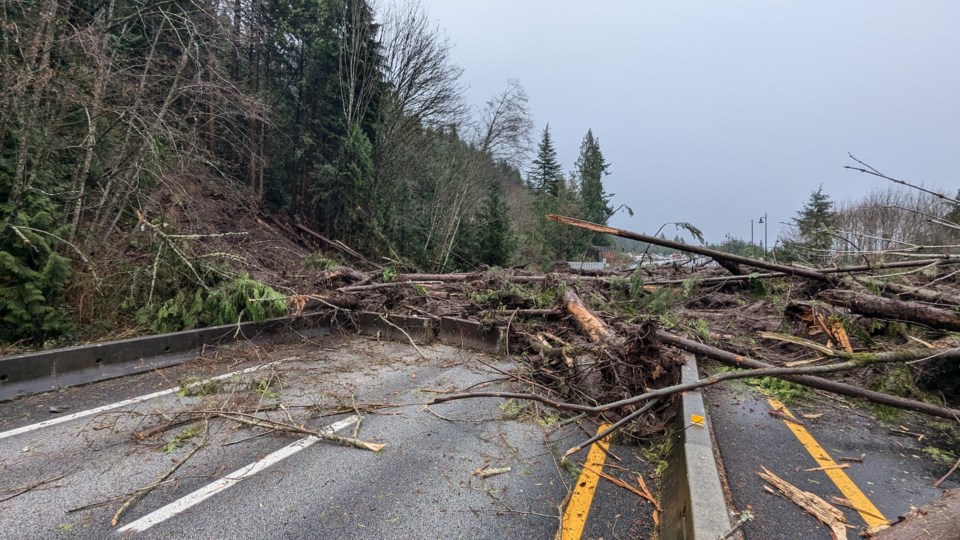When a tragedy occurs, many lessons can be learned from it.
Almost six months after the Lions Bay landslide closed the Sea to Sky Highway for almost 24 hours, District of Squamish staff have brought forward a report highlighting the key lessons they have learned from the natural disaster.
A brief history
Early in the morning on Dec. 14, 2024, a landslide tore through Magnesia Creek, affecting Glendale Avenue at the north end of Lions Bay, and spilling debris across Highway 99, near the Brunswick Beach exit.
Highway 99 was closed in both directions due to the significant debris across the road and railway, which stranded travellers for 18 hours.
Tragically, two Lions Bay residents lost their lives as a result of the landslide.
Lessons learned
District of Squamish councillors received a staff memo on June 3, which recognized the key things that went right during the natural disaster and opportunities for improvement.
Interagency co-ordination efforts, crisis communication and community resilience were noted as some of the key successes.
According to the memo, the District initiated the first co-ordination call between the Emergency Operations Centre, RCMP, and Sḵwx̱wú7mesh Úxwumixw (Squamish Nation) within two hours of the landslide, which facilitated rapid information sharing at the onset of the event.
District staff maintained open lines of communication with regional partners such as the Nation, Squamish Lillooet Regional District and the Resort Municipality of Whistler to maintain “broad situational awareness” as the crisis evolved.
“For example, when the Resort Municipality of Whistler opened their reception centre and group lodging facility, the District shared the information with the public on social media and via Squamish Alert. In addition, District Staff ensured timely updates by participating in ongoing calls with Vancouver Coastal Health and Ministry of Transportation and Infrastructure,” the memo said.
The public was also informed routinely via Squamish Alert and social media messaging as the incident unfolded.
“Based on lessons learned during this event, staff have expanded the list of incident-specific messaging templates within the Squamish Alert system to expedite internal approvals and subsequent dissemination to the public,” the memo said.
One of, if not the biggest success that came from the tragic event was how the Squamish community rallied around those who were left stranded by the landslide.
“The community response to the landslide event highlighted the strong social capital that exists in Squamish, as many local residents and businesses offered support to individuals impacted by the landslide event,” reads the memo.
“Supports included the provision of lodgings, food and sharing relevant information. This is indicative of strong community resilience for future events.”
'Opportunities for improvement'
Regional co-ordination and emergency support services for stranded travellers were noted as two opportunities for improvement within the District’s response procedures.
“Pre-existing informal relationships between local municipalities within the Sea to Sky strengthened regional co-ordination during the event. However, a formalized mechanism for regional co-ordination was identified as a gap,” reads the memo.
“This would allow for an opportunity to ensure unified messaging to the public and optimize the use of limited Emergency Social Service resources during an emergency that has broad impacts across the Sea to Sky Corridor.”
The memo said that District staff are currently working with regional partners to develop a “formalized regional coordination mechanism” that will provide a framework for collaboration and communications during emergency events in the region.
It also notes that there is ambiguity around whether municipalities can reimburse travellers who are stranded as a result of the incident.
“The Emergency and Disaster Management Act (EDMA), managed by B.C.’s Ministry of Emergency Management and Climate Readiness, outlines how municipalities may be reimbursed to operate reception centres and/or group lodging centres during an event response,” reads the memo.
“In the EDMA legislation, there is ambiguity whether these reimbursement mechanisms can be applied to stranded travellers rather than evacuees who have been displaced from their homes.
“Staff will engage with the province to gain further clarity on eligibility for reimbursement on responses that result in stranded travellers.”
At the time of the event, there was very limited vacancy in the hotels in Squamish and Brennan Park Recreation Centre—which is the primary designated facility for group lodgings—was under construction.
“As such, efforts were made to inform the public about the reception centre that was opened in Whistler and Squamish ESS (Emergency Support Service) volunteers were sent to assist in Whistler,” reads the memo.
“To identify future resources for stranded travellers, the District reached out to community partners (e.g. Tourism Squamish and Squamish Chamber of Commerce) to discuss potential assistance that could be offered to travellers impacted by highway closures.
“Additionally, 16 staff and/or ESS volunteers have received Evacuation Registration Tool Assistance training to increase the resource pool of staff who can provide ESS assistance to members of the public during emergencies.”
Visit the District of Squamish website for more information on their emergency program.



